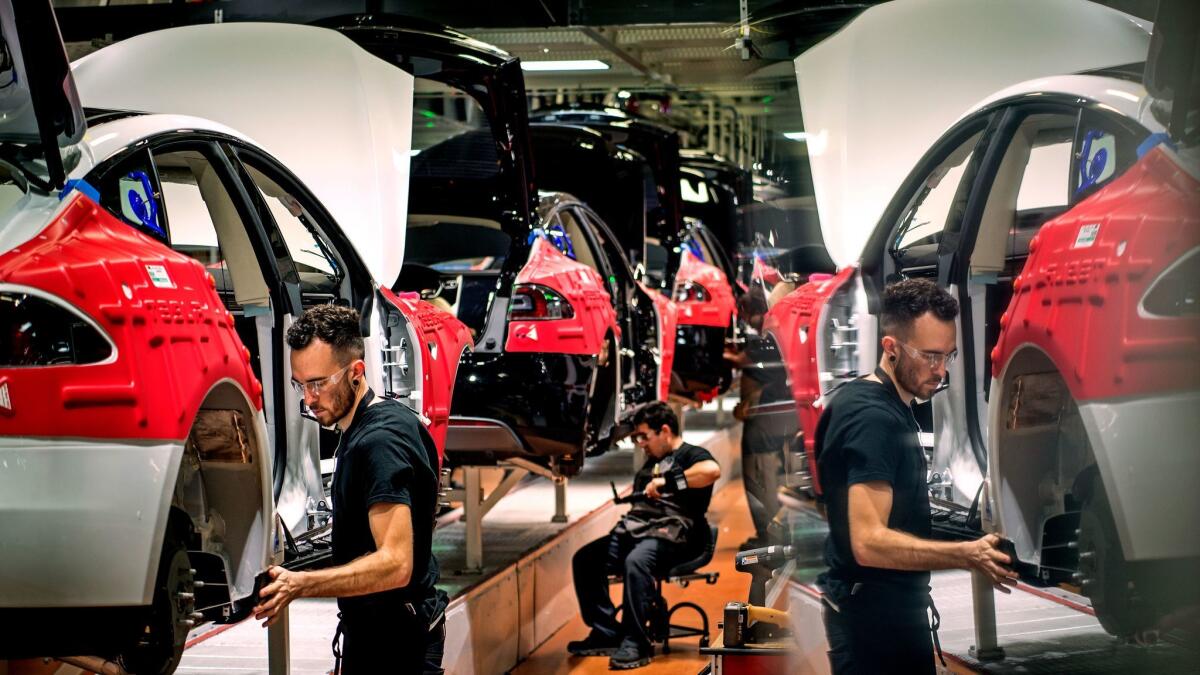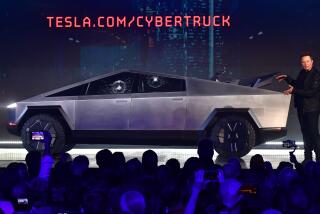Tesla had worse safety records than slaughterhouses and sawmills, but says it’s improving

Elon Musk is moving as fast as he can to replace human workers with robots, but right now he’s dealing with some serious flesh-and-blood issues.
Tesla Motors Inc., the electric car company he runs, is under fire for its record on workplace safety.
On Wednesday, a union-connected group released government safety records obtained by a Tesla employee. The records show a rate of safety incidents reported at the company’s Fremont, Calif., auto plant significantly higher than the auto industry average — as much as 31% higher in 2015.
Indeed, Tesla’s incident rate that year topped some industries commonly associated with risky work, such as sawmills and slaughterhouses.
Tesla did not dispute the numbers. “We may have had some challenges in the past as we were learning how to become a car company, but what matters is the future,” a company spokesman said. “With the changes we’ve made, we now have the lowest injury rate in the industry by far.”
The numbers originally reported to the Occupational Safety and Health Administration, were released by the nonprofit Worksafe. Although not officially public, the company-specific figures are available to employees who request them.
Tesla is a nonunion operation, but the United Auto Workers has been trying to organize workers for years.
Doug Parker, executive director at Worksafe, said on a conference call that “the United Auto Workers called us because they are in the midst of an organization drive.” The UAW passed on worker complaints about injuries, he said.
This month, Tesla on its website described serious efforts to address workplace safety, and the company said it reported incidents for the first quarter of 2017 that are now well below the auto industry average. Those numbers are not yet available.
Bergen Kenny, a Worksafe spokesman, said that one quarter’s statistics aren’t enough to prove a trend.
The report comes at a crucial time for Tesla. This summer, the first mid-market Model 3 is expected to emerge from the assembly line. The company plans to make hundreds of thousands of Model 3s each year. Its success or failure will determine the future of the company.
The safety numbers are based on statistics reported to the federal government under a formula that compares reported injuries to hours worked. The lower the number, the better the safety record.
In 2014, Tesla’s score of 8.4 was 15% higher than the auto industry average of 7.3. In 2015, it was 31% higher: 8.8 to 6.7. Tesla’s score in 2016 was 8.1. The government has not yet made 2016 industry averages public.
Tesla said last year, after worker complaints, that it had it cut mandatory overtime and hired more ergonomics experts.
For the first quarter, Tesla said its safety score had improved dramatically, to 4.6.
The numbers, good or bad, “are indicative, but they’re not conclusive,” said Harley Shaiken, a labor relations specialist at UC Berkeley. “Under the best of circumstances, an automobile assembly plant is a very hard place to work.”
Traditional automakers have extensive experience with safety issues, but Tesla is “a start-up company doing all this for the first time under real pressure,” he said.
The Fremont factory began producing Teslas in 2012. Last year, it turned out about 80,000 Model S and Model X luxury electric cars.
“You’ve had Musk cracking the whip to meet deadlines and stock market expectations, and you clearly in the first four years had a lot of [injury] problems,” Shaiken said.
The Worksafe report did not compare Tesla’s numbers with other industries, but a look at the 2015 Bureau of Labor Statistics report shows Tesla’s 8.8 score that year was on the high end of the scale. Animal slaughterhouses, sawmills, and psychiatric hospitals on average reported lower rates of safety incidents.
The scores don’t account for severity, however. The injuries at Tesla appear to be related to long hours and ergonomic design.
Worksafe put two Tesla workers on the conference call, both on medical leave. Charley Briese said his job involved pulling down a hanging drill three times a minute for 12 to 16 hours a day, causing severe tendinitis.
Alan Ochoa said long hours repeating the same moves over and over with a drill caused enough hand pain to prevent him from working. He was given an office job but said carpal tunnel injuries prevented him from typing on his laptop.
Tesla has made improvements, he said. “But why did they change? They changed because of its union efforts.”
As it’s geared up for the Model 3, Tesla has hired more managers with experience at traditional automakers. The Fremont plant’s head of manufacturing was a top executive at Audi. And the company continues to expand automation at the plant.
Tesla has said that “nothing is more important to us than the health and safety of our employees.”
Twitter: @russ1mitchell







